The power of powder
by John Woods
Australian Shooter May 2002
The cost of handloading your own cartridges is something most readers have noticed an increase in throughout recent years. This is partly because of the poor dollar exchange rate, but also because of a more subtle reason - the simple fact that we shoot a lot more compared to most other countries.
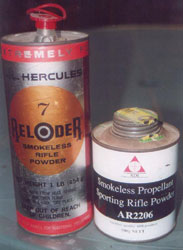
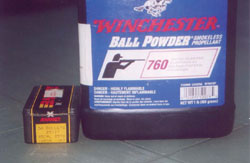 This increases the volume of consumables we purchase and is also compounded by the amount of experimentation that is done in both testing components as well as perfecting loads.
This increases the volume of consumables we purchase and is also compounded by the amount of experimentation that is done in both testing components as well as perfecting loads.
Because of the amount of range shooting and testing done by the handloading enthusiast, I am receiving increasing numbers of requests from people to recommend components in order to minimise their costs in preparing a rifle for the field. Simply put, a short cut. A side benefit of my testing and reviews is that I tend to notice some powders stand out as reliable performers over a range of calibres.
To begin with, we need to understand why there are so many powders available and in so many burning rates, when duplication in performance is so common that several powders appear to work fine for a particular cartridge according to the reloading manuals.
The first fact you need to know about reloading manuals is that they are the only product in the shooting industry I will not review. The last manual I know of that was written based on factual testing was the Hornady Volume 2. In my experience, this is ‘the’ manual, when it comes to stating loads and velocities as compared to my own results chronographing loads.
This is an important factor, because most shooters have no access to a quality chronograph. The reloading manuals are depended on for reliable information but are handicapped if the information is computer ‘guestimated’ and conservatively written. This very reason is why requests for short cuts will never stop.
The reason powders differ in burning rate is because the combustion area within a cartridge varies not only between cartridge case size but also in relation to the bore size. What this means in simple terms is that a .458 calibre bullet fired from a .45/70 case may only have to travel 40mm down the bore before the combustion area of the case doubles.
This causes a severe pressure drop so the answer is to use a powder that is fast burning so that a volume of powder can burn fast enough and keep the pressure up and also the corresponding velocity increasing progressively.
The opposite of this would be the 7mm Remington Magnum, which may require a bullet to travel 140mm down the bore before the combustion area is doubled. In this case, a powder must be selected that will burn more progressively or slower so that the pressure doesn’t build up too fast in the bore before the bullet can get out of the barrel. A backup in pressures would cause the case to expand against the bolt face creating dangerous pressure levels. By using a slower burning powder and allowing a progressive burn and consumption of the powder, the bullet is allowed to travel down the bore continuing to accelerate while the powder builds pressure as the bullet moves away from the case, all the while increasing the combustion area.
Most recommended loads deliver what is termed ‘hunting accuracy’, so the differences in powder selection for a cartridge may alter velocity potential by 150fps or so, with few hunters noticing any difference in performance. Most factory cartridges are at least this far behind the best handloads.
In other words, we could handload a round and if the pressures seemed okay, with no excess pressure signs apparent and with an accuracy level that was deemed acceptable, find instant happiness and satisfaction with our handloading efforts.
This option can make life pretty simple and many hunters still determine their loads in this way. Only when we chronograph loads is the powder choice looked at with more scrutiny because we all like to push the loads as much as practicable to maximise the energy generated and flatten out the trajectories without compromising on the best accuracy achievable.
Having access to a chronograph tends to make poor performance intolerable, especially if you find, for example, that your preferred powder does not achieve the velocity stated in the reloading manuals.
A short cut made through someone else’s experience is therefore preferable in obtaining the information you require in saving money in experimentation. This allows you to go right to the best selections to suit your objectives.
Information or short cuts passed on are always current as long as the powder is available. Some powders shine over others, not only for a cartridge but could cover a range of calibres you may own.
Winchester 760 ball powder is one such powder that shows several advantages, which should be highlighted. The fact that it is a ball powder instead of an extruded stick-type powder means that it meters very well through powder throwers, which is a huge advantage for the volume handloader.
The burning rate of 760 was officially stated to be ‘slightly faster burning’ that IMR 4350. Comparing it to the Australian ‘Mulwex’ Powders makes it a little faster than AR 2209, ADI’s equivalent to IMR 4350. This burning rate makes it one of the most useful and flexible powders you can stock, being ideally suited to a huge range of cartridges from .224 calibre right up to the .460 Weatherby Magnum.
760 really is a medium-slow powder by today’s standard, meaning that it can cover a range of case designs as well as calibres offering very high velocities for calibre as well as covering the range of bullet weights within each calibre.
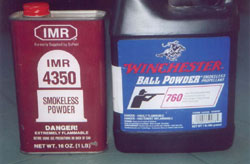
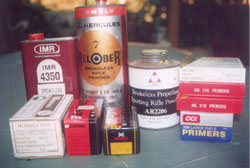
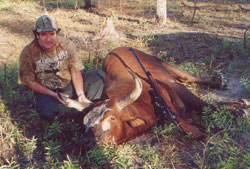 Most readers won’t realise that a case design can influence some powders’ burning rates and Winchester 760 is one of those powders. In a large case with relatively straight sides such as the aforementioned .460 Weatherby, the powder needs to burn quickly to fill the volume of the bore and yet remain controlled enough to be consumed over the time the bullet is inside the barrel.
Most readers won’t realise that a case design can influence some powders’ burning rates and Winchester 760 is one of those powders. In a large case with relatively straight sides such as the aforementioned .460 Weatherby, the powder needs to burn quickly to fill the volume of the bore and yet remain controlled enough to be consumed over the time the bullet is inside the barrel.
Remember here that a .458 bullet only has to travel about 70mm before the combustion area of the powder charge is doubled. This would cause a massive pressure drop resulting in lower velocities if the powder was not controlled with a deterrent coating to allow sufficient volume of powder to remain burning throughout the bullet travel.
The .25/06 may allow a bullet to travel four times that distance down the barrel before the combustion area is doubled, thus demonstrating the need for the powder to take on a slower rate of burning when the case has a restricted case neck design. The .22/250 case is another example where this applies and Winchester 760 also performs well in this essentially overbored, bottlenecked case design. This is not an isolated phenomenon and is again seen by comparing IMR4198 or AR 2207 in the .458 calibre cartridges, where these powders are termed ‘fast burners’.
When these fast burning powders are used in the smaller calibre, relatively large volume cartridges for their bore size, such as the .222 and .223 Remington’s, these powders take on slow burning characteristics in the bottlenecked case. This phenomenon is caused by certain variations in case shape. Because of a case shape difference such as a bottleneck compared to a straight-sided case, this may cause the powder to burn at a different rate. When the powder charge is constricted by a reduced shoulder and bottleneck, exampled by the .222 Remington case, a rifle powder considered fast burning, such as IMR 4198, may take on slower burning characteristics because of the small volume of the powder charge and the control of the burning that is caused by the restricted size of the case mouth.
In a larger volume case such as the .45/70, which is straight sided, the case requires a fast burning powder to maintain pressures in that large bore. This same IMR 4198 in that case, which allows for fast escape of burned powder due to the open case mouth, will allow the powder to be a fast powder.
It is safe, however, because the powder volume used is in relation to the bore size’s ability to consume the charge within safe pressure limits.
Using Winchester 760 for an example, with my own experiences, I find that a healthy range of calibres, including .224, .243, .257, .277. 7mm, .308, .338, .375 and .458, all produce superior performance in both velocity and accuracy.
When you are handloading a new cartridge for the first time, it is common to want to use a powder you already have in stock to help reduce costs. I would recommend this because it allows you to spend a little extra on the bullet, which is of far greater importance in a hunting rifle.
There is a huge range of powders available and the overlap in performance is just as great. You may have a smallish bore in the .224 to .257 calibre range and several powders will work in this range to achieve good performance. The powders I would select are the those that use the most number of grains because you will achieve more uniform velocities from a powder that uses more powder simply because any inaccuracy in your measurements will be reduced as a percentage of volume.
Another thing to remember is that slower powders are safer to use in full loads because pressure is lower initially and any unburned powder that is not consumed within the barrel will be blown out the muzzle.
Benchrest shooters commonly use powder throwers and I have met few who know the actual loads they are using simply because they concern themselves only with accuracy and ‘acceptable’ pressure. Velocity is not as important.
The hunter is requiring velocity for two main reasons: firstly, to flatten out trajectories to enable longer shots and secondly, to maximise the kinetic energy of the bullet at point of impact.
I have changed my opinion a little in recent years regarding the need for energy, as I have found that the superior bullet technology available today provides all the penetration required for most needs. Energy is irrelevant when penetration is complete.
This brings us back to powders. So, to sum up a recommendation on powders selection, I would still go with the slowest powder you have in stock that most fills the case volume for the bullet weight you wish to use. If you are not able to achieve the velocity potential of the cartridge with your existing stock, then that would be the time to look for a new powder choice to work with.
I would also definitely recommend purchasing your powder in large volumes. It is a fact that powders vary from batch to batch in their burning rate. What this means to the handloader is that you may have to work up a load again to recheck the performance if you purchase a new tin of powder and find the batch number is different.
The industry standard for burning rate variation is four per cent but I have experienced up to twice this during my testing. I have also noted that some powders do not ‘travel’. This means that a load worked out in a particular place, climate and altitude does not perform as well when you are hunting elsewhere.
While hunting overseas, I have experienced accuracy going off so far the rifle became useless. This fact was confirmed when a few spare loads I had containing another brand of powder shot exactly as they did in my home town. When the first loads were again tried, the accuracy was still unusable. Upon returning home, these bad loads performed exceptionally well, as they originally tested. This proved conclusively that the powder was not to be trusted for oversees use, where climatic conditions and altitude may vary.
While this phenomenon is more common with a particular brand of powder in my experience, it just the same demonstrates the need to consider volume purchasing in the interests of ensuring uniformity in your handloads years into the future.
All powder containers have a batch code imprinted on them and it is important that when you purchase bulk powder, usually in smaller containers, that the batch number and dates are the same. By ensuring consistency with your powder, you will be able to trust the handloads you work up with that particular batch of powder.
